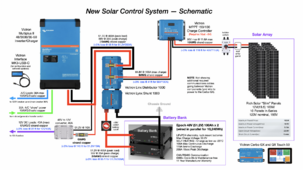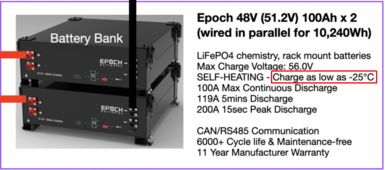MegaMosquito
New Member
Some background (why I chose this specific design):
I have a small (24 foot long) motorhome with a 30A shore service. I have designed an off-grid 1kW solar array (the most I can fit on the roof) and a 10kWh battery bank with a 3kW inverter so we can sometimes "boondock" when we travel (i.e., park in places where we cannot plug in to the grid). I wish I could add more solar for charging this big battery bank, but 1kW is the most I can fit (and that is very tight). We want to be able to boondock as much as possible but we realize that we may sometimes need to stay at a campsite with hookups to top up the batteries (we need that to dump waste water from time-to-time anyway). I designed the solar array with ten 12V 100W panels in series because I understand that serial setups are going to enable charging earlier in the morning, and later in the afternoon, than parallel setups. As a result, the solar array has an open current rating of 195V. I only have enough space for 10kW of battery in the form of two rack-mount 48V (nominal) 51.2V 100Ah batteries. I'm planning a 3kW inverter (i.e., 25A at 120V) so I can power almost everything that I can power from the 30A "shore" connection. Another option might be an inverter of 3.6kW (30A at 120VAC) or more, but the inverter is for boondocking when we will hopefully be conserving power. So I think we can live with 3kW.
The best controller, inverter, monitor, etc. system I have found so far for this setup is an all- Victron Energy system. I considered less expensive all-in-one systems (like EG4) but the Victron system gives me complete flexibility for each component and I also really like the CerboGX monitoring system.
I have bought nothing yet.
I'm new to all of this so I am really hoping you can criticize my design before I buy all this expensive stuff and begin this project.
Here's my design:

So what do you think? What would you change if this was your project?
Thanks in advance!
I have a small (24 foot long) motorhome with a 30A shore service. I have designed an off-grid 1kW solar array (the most I can fit on the roof) and a 10kWh battery bank with a 3kW inverter so we can sometimes "boondock" when we travel (i.e., park in places where we cannot plug in to the grid). I wish I could add more solar for charging this big battery bank, but 1kW is the most I can fit (and that is very tight). We want to be able to boondock as much as possible but we realize that we may sometimes need to stay at a campsite with hookups to top up the batteries (we need that to dump waste water from time-to-time anyway). I designed the solar array with ten 12V 100W panels in series because I understand that serial setups are going to enable charging earlier in the morning, and later in the afternoon, than parallel setups. As a result, the solar array has an open current rating of 195V. I only have enough space for 10kW of battery in the form of two rack-mount 48V (nominal) 51.2V 100Ah batteries. I'm planning a 3kW inverter (i.e., 25A at 120V) so I can power almost everything that I can power from the 30A "shore" connection. Another option might be an inverter of 3.6kW (30A at 120VAC) or more, but the inverter is for boondocking when we will hopefully be conserving power. So I think we can live with 3kW.
The best controller, inverter, monitor, etc. system I have found so far for this setup is an all- Victron Energy system. I considered less expensive all-in-one systems (like EG4) but the Victron system gives me complete flexibility for each component and I also really like the CerboGX monitoring system.
I have bought nothing yet.
I'm new to all of this so I am really hoping you can criticize my design before I buy all this expensive stuff and begin this project.
Here's my design:

So what do you think? What would you change if this was your project?
Thanks in advance!
Last edited:





